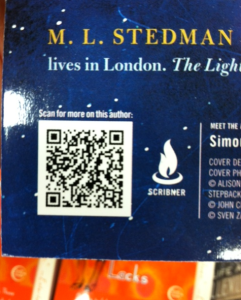Scribner, The Publishing Industry, and QR Codes
Posted on by Timothy Boyle I was at my local Barnes & Noble the other day browsing for a new book to go along with the other ten half read books on my night stand when I picked up a book titled The Light Between Oceans, by M. L. Stedman. I don’t typically read fiction, now was I particularly interested in this book, but for some reason I picked it up to read the back. Much to my delight I found a gift in the form of a QR code staring back at me. Evidence that publishers—in this particular case Scribner Publishing—are finally beginning to use this tool that has huge potential for the industry.
I was at my local Barnes & Noble the other day browsing for a new book to go along with the other ten half read books on my night stand when I picked up a book titled The Light Between Oceans, by M. L. Stedman. I don’t typically read fiction, now was I particularly interested in this book, but for some reason I picked it up to read the back. Much to my delight I found a gift in the form of a QR code staring back at me. Evidence that publishers—in this particular case Scribner Publishing—are finally beginning to use this tool that has huge potential for the industry.
What Scribner Publishing used this particular QR code for was to introduce M.L.Stedman to potential readers. The reason for this was that this book, The Light Between Oceans, was Stedman’s debut novel. Thus he likely is not well known to many potential readers and the QR code intends to help change that.
With the QR code a potential reader now has the ability to learn more about the author and more about his new novel. In fact, Scribner Publishing provides some engaging content in the form of a video introducing Stedman and his work, as well as a short write up.
 In addition to sharing the good word about Stedman, the Scribner mobile page also allows potential customers to learn about other authors and books that they publish, as well as share on social networks this particular book and author. Both great ways to advertise and increase sales.
In addition to sharing the good word about Stedman, the Scribner mobile page also allows potential customers to learn about other authors and books that they publish, as well as share on social networks this particular book and author. Both great ways to advertise and increase sales.
Though this is a nice little use of a QR code, there really is much more potential with QR codes in the publishing industry.
For example let’s take a book like The Da Vinci Code, by Dan Brown. There is a ton of content referenced in that book including art work, statues, engravings, city maps etc. that cannot be visually shown in the book without adding many pages. However, if small QR codes were placed throughout readers could then be connected with this content in a visual way so as to understand more deeply what it is they are reading. The reading experience is now an interactive one, and far more interesting.
In a more obvious way QR codes can be used in non-fiction books, perhaps an economics book might use QR codes to point out various sources, graphs, or other visual evidence that helps the point being discussed. Or perhaps a history book on ancient Greece uses a QR code to take the reader to photos of the fields of Marathon, or the Acropolis. Or perhaps a Biography on Martin Luther King might use a QR code to take the reader to a video of his famous “I Had a Dream” speech.
This is a start for Scribner Publishing, but as you can see there is a huge realm of possibilities with this great tool. Publishers just need to start thinking outside of the box.
QR codes allow publishers to connect the physical world with the online world and greatly enhance the reading experience of their consumers. I do not think it is a stretch to say that the tool of QR codes can greatly alter the future of publishing and our daily reading experience.

